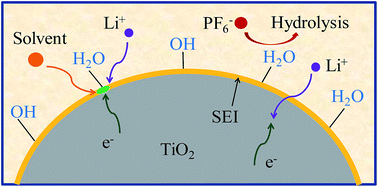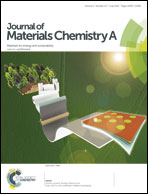Hollow titanium dioxide spheres as anode material for lithium ion battery with largely improved rate stability and cycle performance by suppressing the formation of solid electrolyte interface layer†
Abstract
By subjecting amorphous titanium dioxide (TiO2) colloidal spheres as a scaffold to a two-step external template-free hydrothermal treatment, anatase TiO2 hollow spheres with an average diameter of 410 nm and shell thickness of 65 nm were successfully yielded. Such hollow TiO2 nanostructures possessed a large surface area, abundant active sites and reduced Li ion diffusion path and thus were highly favorable for use in TiO2-based lithium ion batteries (LIB). Electrochemical measurements revealed that as-prepared TiO2 hollow spheres exhibited specific discharge capacities of 296, 185, 118, 66 and 37 mA h g−1 at 0.1 C, 1 C, 2 C, 5 C and 10 C, respectively. This is in sharp contrast to the considerably lower values obtained in TiO2 solid nanoparticles (i.e., 182, 119, 81, 43 18 mA h g−1 at discharge rates of 0.1 C, 1 C, 2 C, 5 C and 1 0 C, respectively). Interestingly, TiO2 hollow spheres showed a large irreversible capacity loss and relatively low cycling performance due to the residual chemisorbed water in TiO2 and hydroxyl groups present on the TiO2 surface. A solid electrolyte interface (SEI) layer composed primarily of Li2CO3, lithium alkyl carbonates and organic phosphates was thus formed on the surface of hollow TiO2 spheres, thereby leading to an increased internal cell impedance and the decreased rate and cycling performance. The subsequent high-temperature annealing effectively removed chemisorbed water and hydroxyls on the TiO2 surface. As a consequence, annealed TiO2 hollow spheres rendered markedly improved rate stability and cycle performance in the resulting TiO2-based LIBs. The specific discharge capacities at rates of 5 C and 10 C were 77 mA h g−1 and 50 mA h g−1, which are considerably larger than those obtained from as-prepared TiO2 hollow spheres. Moreover, compared to only 42.1% for as-prepared hollow TiO2 spheres, a capacity retention as high as 93.5% over 200 cycles at 1 C was achieved for annealed hollow TiO2 spheres.



 Please wait while we load your content...
Please wait while we load your content...